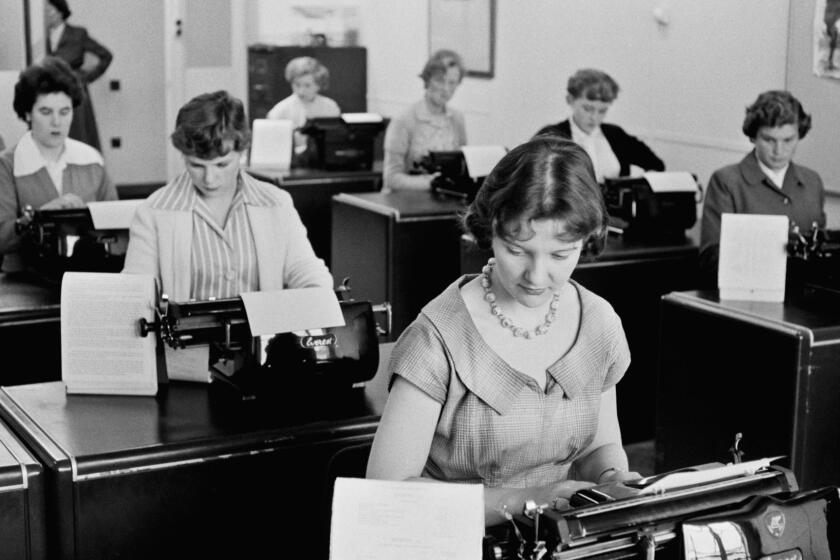Too many women are leaving the workforce during the pandemic. It’s time for men to lean in and help
- Share via
Men who thought the COVID-19 “she-cession” was misnamed should take a look at the recent figures from the U.S. Bureau of Labor Statistics. After disproportionately losing jobs during the early shutdown, women are now leaving the workforce at nearly four times the rate of men.
With so many women laid off, sidelined or stepping away to manage remote schooling or care for their families, men have to stand up as allies to ensure that gender equality in the workplace isn’t set back a generation.
The corrosive effect of this downturn is already evident. The wage gap is widening toward where it was nearly 20 years ago by some economists’ estimates. Men, meanwhile, are 2.3 times more likely than women to say that working from home during the pandemic has been positive for their careers.
These are not “women’s issues.” These are issues that demand men play a role in disrupting the status quo. We have spent the last seven years researching how men can effectively promote gender fairness at work. We often find that men believe in gender equality but are missing when it comes to taking action. And there are evidence-based strategies that men can employ now to advocate for women in their workplace.
It started as a viral newspaper column in 2014, intended as a communication guide for men.
First, men need to proclaim their own family priorities. For too long, men have been reluctant to leave work loudly when they have obligations such as parent-teacher conferences or a sick child at home. Slinking out the side door instead of being public about where they’re going and why is a missed opportunity to level the playing field for women and embolden other men.
Men need to be transparent at work about family responsibilities, including taking full parental leave, sick leave and requesting flextime arrangements that support their partner’s career and household demands. When men publicly embrace these benefits, they destigmatize the domestic work that is linked to a motherhood penalty for women.
Additionally, men need to dedicate time for mentorship in the virtual workspace. Remote work could remain the norm for months to come. That puts women at higher risk of becoming invisible. Men should check in with the women they mentor and reach out to help female colleagues whose mentors may have voluntarily or involuntarily left the workplace, leaving them without a coach or advisor. These offers should also go to women who may not yet have established any mentorships.
In all cases, men should contextualize their motivation for a mentoring check-in. This includes affirming strong job performance and offering an open door for career conversations and advice about advancement tracks at their company. Additionally, men mentoring women need to listen and validate their colleagues’ challenges and concerns.
Men can also support female colleagues by championing flexible work. During the pandemic, more leaders have observed the benefits of adaptable hours and locations, especially for working parents. Men in decision-making positions — and they do hold 75% of C-suite jobs — need to lend strong backing to initiatives such as paid parental leave, creative telework arrangements and childcare consortiums. When men advocate for such policies and benefits, they become destigmatized for women and other men.
Reevaluating job performance criteria is an additional step men can take in their organizations. In reviews, women are generally evaluated with more negative language, offered less direct and useful feedback, judged more harshly on mistakes and penalized for using flexible work arrangements. Reduced face-to-face time opens the door for even more biased assumptions and negative evaluations.
Women are clearly feeling this. Mothers are twice as likely as fathers to be worried about being evaluated negatively because of their caregiving responsibilities during the COVID-19 crisis, according to “Women in the Workplace” research by McKinsey & Co. and Leanin.org. These worries compound stress and burnout.
Managers should look at their job performance benchmarks and adjust for pandemic challenges. Then they should rewrite performance review criteria, in conjunction with their companies’ human resource departments. The research found that only 30% of companies had done so this year and just 5% had suspended performance reviews altogether.
Finally, companies need to track gender as it relates to important employment outcomes like promotions and raises, as well as furloughs and layoffs. This data can heighten awareness of, and mitigate, systemic bias.
And when workplaces look to increase hiring, especially once the pandemic ends, men at those companies should forcefully advocate for employing women, and creating strategies to pull women back into the workforce without loss of rank or pay, including reaching out to those who left or were laid off. Men in hiring positions need to practice this, not just preach it.
At the end of last year, more than half of U.S. jobs were held by women. That means the COVID-19 pandemic isn’t just a disruption for women, but also critical to women’s roles in the whole economy. As we contemplate returning to re-envisioned workplaces in 2021, men should look at what this crisis has shown them about the challenges women face at work — and do something about it.
W. Brad Johnson is a professor of psychology at the U.S. Naval Academy and a faculty associate at Johns Hopkins University’s graduate school of education. David G. Smith is a professor of sociology at the U.S. Naval War College. Their most recent book is “Good Guys: How Men Can Be Better Allies for Women in the Workplace.” This article was produced with Knowable Magazine.
More to Read
Updates
5:20 p.m. Dec. 4, 2020: This article has been updated to reflect that McKinsey & Co. and Leanin.org conducted the “Women in the Workplace” research.
A cure for the common opinion
Get thought-provoking perspectives with our weekly newsletter.
You may occasionally receive promotional content from the Los Angeles Times.










